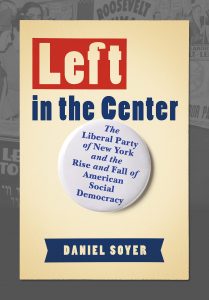Left in the Center: The Liberal Party of New York and the Rise and Fall of American Social Democracy
L eft in the Center: The Liberal Party of New York and the Rise and Fall of American Social Democracy, by Daniel Soyer. (Ithaca: Cornell University Press, 2021)
eft in the Center: The Liberal Party of New York and the Rise and Fall of American Social Democracy, by Daniel Soyer. (Ithaca: Cornell University Press, 2021)
The Liberal Party was central to the political history of New York State in the second half of the twentieth century. A third party that arose in 1944 and lasted into the twenty-first century, it was a force in state, local, and even national elections. The Liberals advertised themselves as a force for social democracy, an anti-communist alternative to the American Labor Party, and a good government option instead of the boss-ridden Democratic and Republican Parties. Yet as Daniel Soyer clearly demonstrates in Left in the Center, the direction of the party was clearly top down rather than bottom up and managed by such needle trades leaders as the hatters’ union’s Alex Rose and the ladies’ garment workers’ David Dubinsky.
Soyer’s study is not only a long overdue biography of this party, but also an invaluable source for more than a half century of New York politics. Having established himself as a leading historian of the Big Apple, especially its East European Jewish community, he outdoes himself with an account that is both highly detailed and well-written. Though replete with colorful characters, such as Dubinsky, John V. Lindsay, Vito Marcantonio, and Edward I. Koch, the book resists the temptation to engage in gossip and sensationalism, despite numerous opportunities. The abundance of such New York political characters, such as Rudolph Halley, Carmine DeSapio, Newbold Morris, and Rudolph Giuliani, is enticing, but, alas, as Soyer demonstrates, the party went downhill with the likes of party boss Raymond Harding, and left people of good intentions wondering what happened.
In 1936, when the president of the hatmakers’ union, Max Zaritsky, David Dubinsky and others created the American Labor Party to give President Franklin Roosevelt an additional ballot line in his bid for reelection, it may be argued that the Liberal Party had a noble, if blatantly practical, origin. The ALP indeed helped FDR, as it also did Fiorello La Guardia in his domination of City Hall for more than a decade, but almost from its inception demonstrated that its leaders could not avoid being politicians and ideologues, battling interminably to steer it to the Left or Right. Though led by a master tactician, Alex Rose, an inevitable split drove the Right into creating a new Liberal Party. Abandoned and alone on the Left, and identified with charismatic East Harlem congressman Vito Marcantonio, the remnants of the ALP fought a losing battle to remain relevant as the Cold War captured American politics and the Soviet Union emerged as a bitter adversary.
After ably chronicling this schism, Soyer tells the story of a party seeking to rekindle its former flames. Though, no longer on the coattails of FDR, it attached itself to various causes that served social democracy and clearly improved the lives of ordinary New Yorkers, to the dismay of those who regretted spending for public purposes and supporting organized labor. It was a heyday for liberalism, associated in the early 1960s with Presidents John F. Kennedy and Lyndon Johnson, but doomed immediately afterward by urban unrest and protest over a misbegotten war in Vietnam. Elected in 1965, and determined to keep the progressive standard aloft, John V. Lindsay maintained the Liberal Party’s imprint on City Hall, but after two controversial terms in office found himself and social democracy widely reviled as economic forces drove New York City and State into near bankruptcy by the mid-1970s. As he faced his second term, Lindsay bore a legacy of “turmoil, including strikes of transit and sanitation workers, and teachers; rising crime; clashes over the Vietnam War, and polarization around cultural change.” The deluge followed afterward. Accused of wasteful spending and facing urban decay and division, Liberals and their allies went into retreat. With the founding leadership now gone from the scene, the Liberal Party barely remained alive through guile and manipulation rather than its purported ideals.
Soyer’s mastery of his material is amazing. Writing clearly in crisp sentences, he draws upon archives from a dozen institutions and about twenty oral histories, plus numerous periodical sources. Without embellishment, his account of the Liberal Party’s twists and turns comes across as clear and authoritative. At long last the Liberal Party has received its due. As evidence of its political legacy, Soyer concludes by citing today’s third-party successors, the Conservative Party, and more akin to the Liberals’ views, the Working Families Party.
Reviewed by Prof. Robert D Parmet, York College, City University of New York
